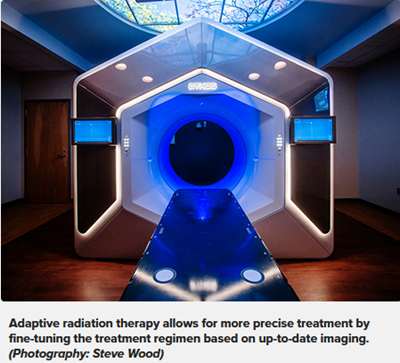Source: www.uab.edu
Author: Bob Shepard
They are calling it radiation oncology’s contribution to personalized medicine. — called by some the holy grail of radiation therapy — has come to the University of Alabama at Birmingham O’Neal Comprehensive Cancer Center in the form of the newest radiation delivering tool, a system called Ethos from Varian.
Simply put, a linear accelerator is the machine that is used to deliver radiation therapy to destroy a tumor. In standard radiation therapy, the medical team uses sophisticated imaging to pinpoint the location of a tumor, then develops a precise approach to target that tumor with radiation.
“Patients typically get a CT scan so the radiation team can map out their strategy, a process that can take one to two weeks,” said Dennis Stanley, Ph.D., an assistant professor and medical physicist in the UAB Department of Radiation Oncology. “Then, most patients get radiation for around six weeks, usually five days a week.”
But in that time from initial CT screening to the end of treatment, things can change.
“A patient’s anatomy can change over this time period,” Stanley said. “Weight gain or loss, shifting of tissues following eating and drinking. Anatomy can change as quickly as day-to-day.”
Adaptive therapy simply means the radiation plan can adapt to those changes. The Ethos system is the first machine that can quickly scan a patient while they are on the treatment table prepping for their next treatment, and allow for fine-tuning of the already established treatment plan. Instead of following a rigid treatment plan over the course of several months, adaptive therapy can make adjustments to the plan as needed on a weekly or even daily basis.
“We can re-image the patient while they are on the table, and compare the patient’s initial anatomy to the patient’s current anatomy,” said Samuel Marcrom, M.D., assistant professor in the Dept. of Radiation Oncology. “If there have been changes, we can tweak the plan almost instantaneously. The result is a more accurate radiation treatment based on real-time information, creating an opportunity for more radiation to be delivered to the tumor with less radiation delivered to healthy tissue nearby. It is a personalized medicine approach for radiation oncology.”
UAB Medicine and the Department of Radiation Oncology are among the first in the nation to install an Ethos system. There are only 12 currently operating in the United States.
UAB used the Ethos system for the first time on Aug. 10. Stanley and Marcrom say it can be useful for many types of cancers, especially for prostate and cervical cancers due to the propensity of the internal anatomy to change over time in the pelvis. UAB will first treat pelvic tumors with Ethos, gradually moving toward lung and chest cavity cancers. Ethos is also suited for head and neck cancers.
Ethos is the newest tool in the rapidly advancing field of radiation oncology. UAB added proton therapy in March 2020 when Proton International at UAB became the first proton therapy center in Alabama. Proton therapy uses highly precise proton beams instead of traditional X-rays to treat the tumor, leading to more precise and conformal treatment of the tumor with less dose to normal tissues.
“Ethos is another tool that helps aim radiation at the tumor target and avoid healthy tissue, much as proton therapy does,” Stanley said. “This is a valuable option for patients who are not candidates for protons, or any of our other radiation delivery systems.”
UAB’s Ethos system is the first in the world to use the Varian Identify Surface imaging system in conjunction with the Ethos delivery system for patient monitoring and localization. This allows for more accurate positioning and monitoring of patients throughout the course of treatment without adding any extra radiation.
“Ethos gives us options that we haven’t had before,” Marcrom said. “We are able to treat a patient’s cancer based on what it looks like right now, not what it looked like days or weeks earlier. That is a significant advantage.”


Leave A Comment
You must be logged in to post a comment.